Are you looking for the best calisthenics workout you can do at home?
You’re in the right place.
After reading this post, you will learn:
- how to train your entire body with calisthenics (even if you are a beginner),
- the best exercises to include in your workout to master your body weight, and
- simple calisthenics progressions to keep your workouts challenging
Let’s get started.
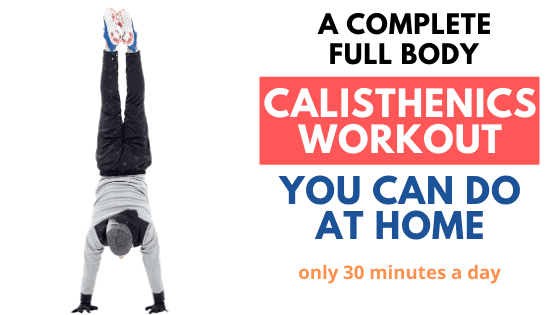
What is A Calisthenics Workout?
A calisthenics workout is a form of exercise that uses your own body weight as resistance.
In many ways, it is very similar to traditional gym workouts that involve free weights. The only difference is that you have to learn how to use your body weight to create different levels of intensity for each muscle group.
If you cannot or do not want to go to a gym, calisthenics is a great alternative for improving strength, flexibility, endurance, and coordination.
As of late, it is my go-to form of strength training.
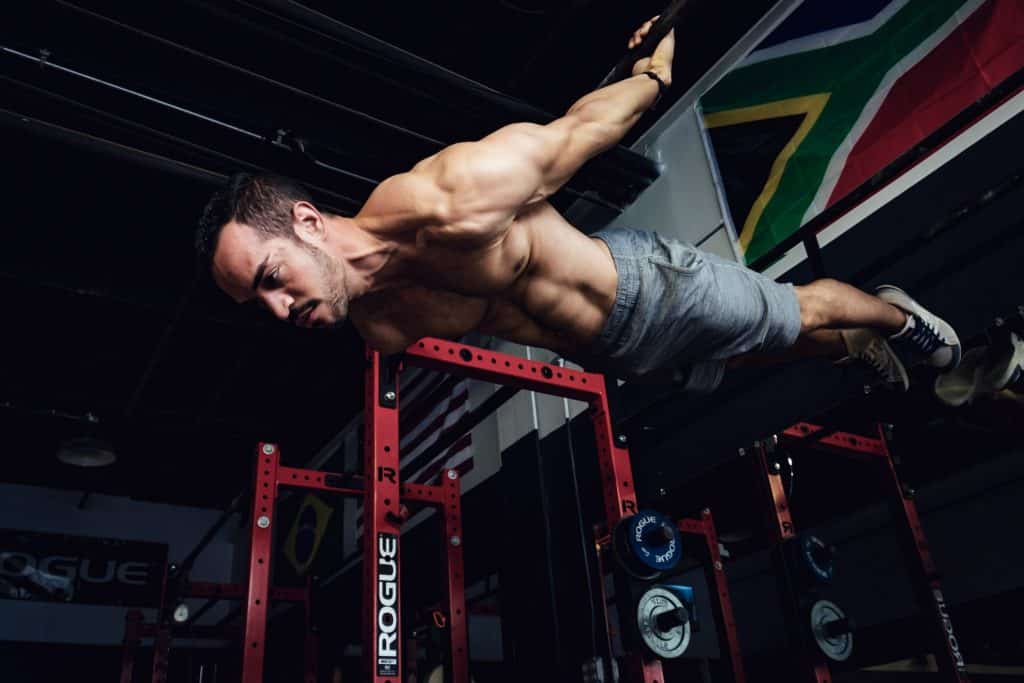
How Can I Practice Calisthenics At Home?
The great news is, you can begin practicing calisthenics workout routines at home.
In fact, you can start RIGHT NOW if you want.
All you need is a plan to guide you.
The first thing you need to know is how to train all the major muscle groups using just bodyweight movements.
Let me show you how.
How Should A Beginner Start Calisthenics?
As a beginner, the first thing you need to focus on is learning how to do the basic calisthenic exercises with good form.
One of the biggest mistakes you can make is using exercises that aren’t appropriate for your skill level.
The great thing is, you can find numerous progressions or regressions to all of the major calisthenic exercises.
Let’s talk about those major exercises now.
The Three Basic Calisthenics Movements
In general, there are three broad types of calisthenics moves. They are:
- The Push Calisthenics Exercises
- The Pull Calisthenics Exercises
- The Leg Calisthenics Exercises
Let’s go over each one in more detail.
Push calisthenic exercises
The first category is the push exercises. These movements primarily train the anterior side of your upper body.
Specifically, the chest, shoulders, and triceps.
The most basic exercise example is the push up. As underwhelming as this exercise may sound, there are dozens of ways to add complexity and varying levels of difficulty to this movement.
More on that later.
Pushing exercises also involve more advanced movements such as handstands.
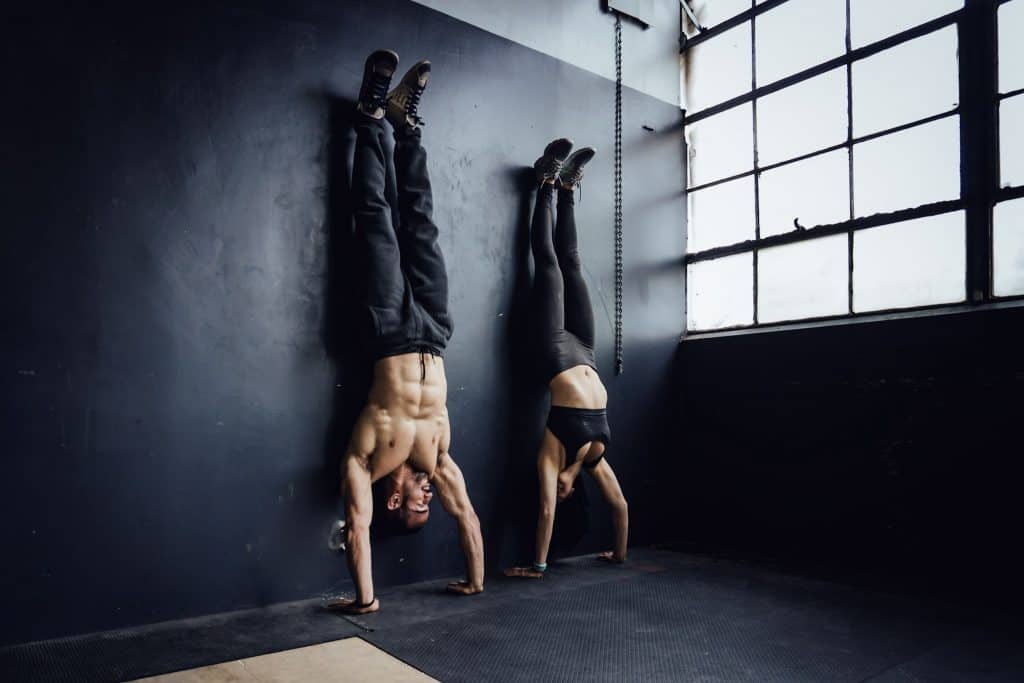
Pull calisthenic exercises
The second category is the pull exercises. These movements primarily train the muscles in the posterior side of your upper body.
Specifically, the rhomboids, the lats, the trapezius, the posterior shoulders, and the biceps. The major caveat is that calisthenic pulling exercises need some sort of equipment such as a
The most basic exercise example of this movement is the pull-up or the bodyweight row.
Leg Calisthenic Exercises
The last category is leg exercises.
These movements involve different kinds of squats, lunges, and hip extension exercises to strengthen the quadriceps, hamstrings, and gluteal muscles.
The major disadvantage of pure bodyweight leg exercises is that you will eventually outgrow them. Your legs are extremely powerful, and your bodyweight simply won’t provide enough resistance to continuously stimulate them.
With that said, if you can do pistol squats (one of the more advanced leg exercises), your legs are pretty strong.
The Ultimate Calisthenics Workout (For Beginners)
Alright, let’s get to the workout. I would like to say that this is a complete no-equipment workout, but that wouldn’t be completely accurate.
In order to get the most out of this workout, or any at-home workout, you will need a
This is such a simple one-time investment that will provide you with enormous benefits.
Just get one.
Warm-up
As with all exercise routines, the very first thing you need to do is warm-up.
Warm-ups are absolutely necessary if your goal is to stay healthy. Failing to warm-up can increase your risk of injury, especially as you get stronger.
The good news is, a warm-up doesn’t have to take longer than 5 minutes.
The most important thing to do is get your heart rate up, elevate your temperature, and get your joints moving through their full range of motion.
Jumping jacks, arm circles, bodyweight squats, lunges, push-ups with your hands elevated are all great exercises you can do to get started.
I go over an entire warm-up routine you can do in The 5 Minute Calisthenics Warm-up.
A Classic Push Pull Legs Calisthenics Workout
After you are done warming up, you can begin your calisthenics training.
For this workout, you will be performing a variation of the popular push-pull-legs split.
However, instead of only training the push muscles on one day, the pull muscles on another, and the leg muscles on a different day, you will be training all three muscles groups in the same workout.
Here’s how:
Workout 1
| Exercise | Sets | Repetitions |
|---|---|---|
| Push-up Variation | 3 | 8 |
| Inverted Row Variation | 3 | 10 |
| Squat Variation | 3 | 10 |
In this workout, the push exercise will be a push-up variation that challenges you in the 8 repetition range.
This might be an incline push-up with your hands elevated on a ledge, a close grip push-up, or a one handed-pushup depending on your skill level.
In this post, I go over a few different push-up progressions or regressions you can do.
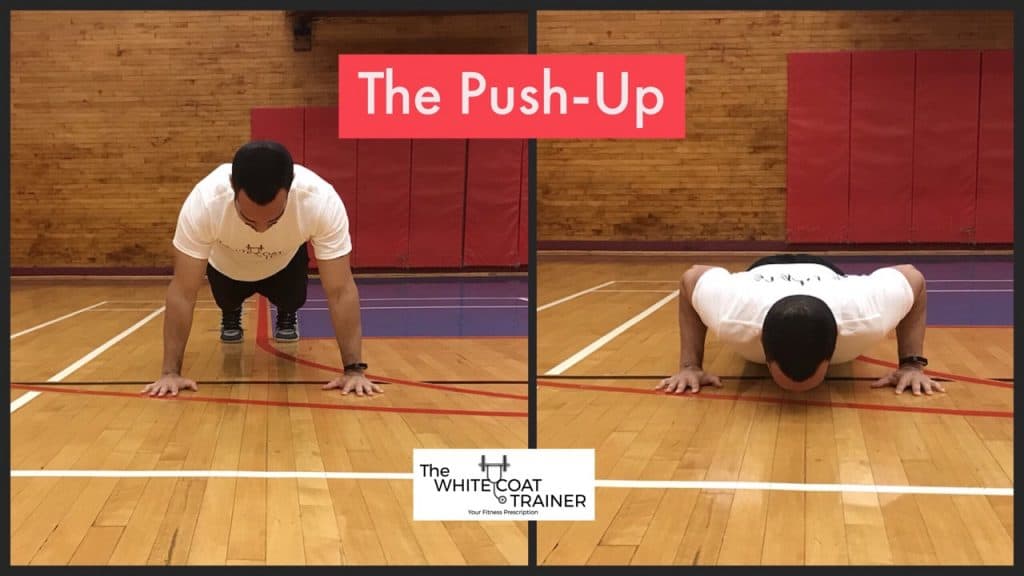
The inverted row is a type of horizontal pulling exercise.
In order to do it, you will need a sturdy table to do it.
Here’s what it looks like.
Just make sure to have a weight on the table to counterbalance yourself.
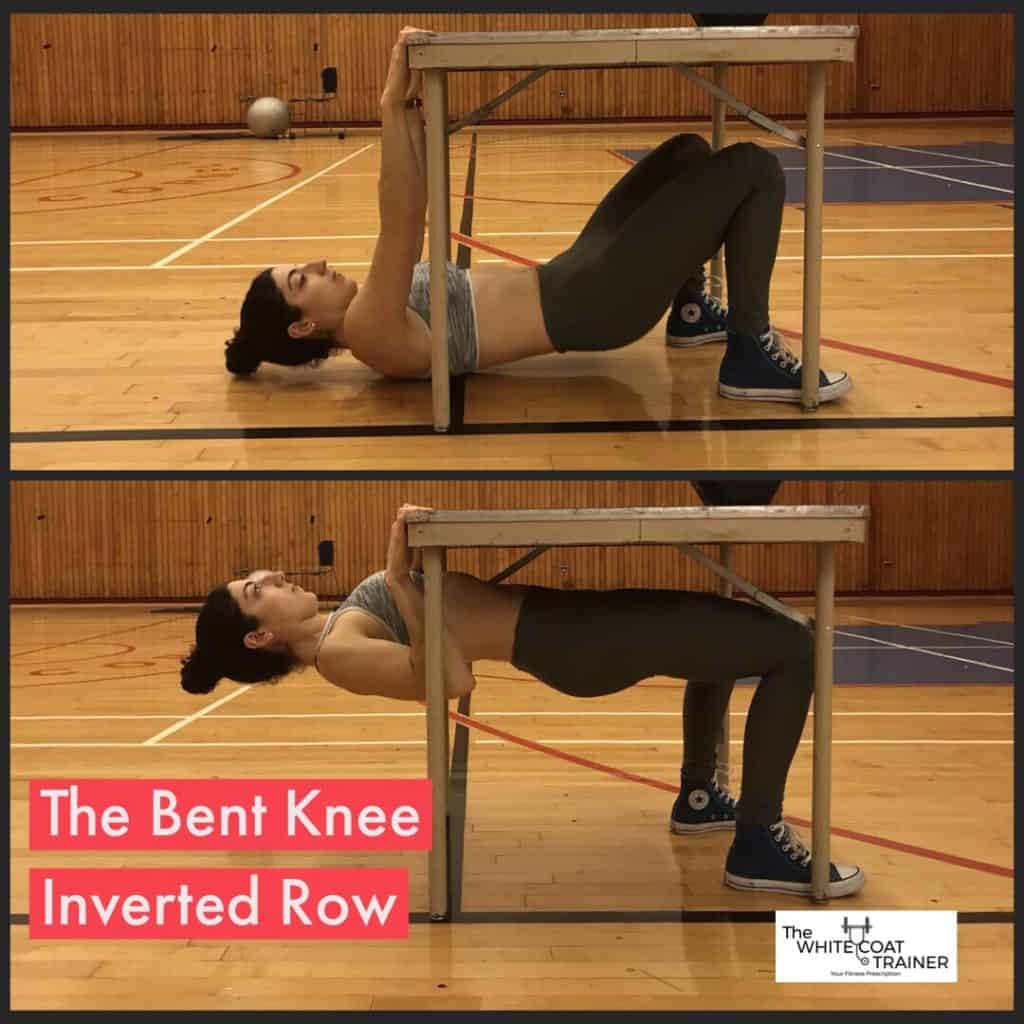
If you don’t feel comfortable doing this exercise, you can also try wall pulls.
Lastly, the squat variation is pretty self-explanatory. Find a squat variation that you can find challenging. I go over a few squat variations here.
Workout 2
| Exercise | Sets | Repetitions |
|---|---|---|
| Pike Push-up | 3 | 8 |
| Pull-up Variation | 3 | 8 |
| Glute Bridge Variation | 3 | 10 |
In this next workout, your push exercise will be the pike push-up.
This movement is one of the prerequisites for more advanced exercises like the handstand push-up. It primarily strengthens the shoulders in a vertical pushing movement pattern.
Here’s how it looks:
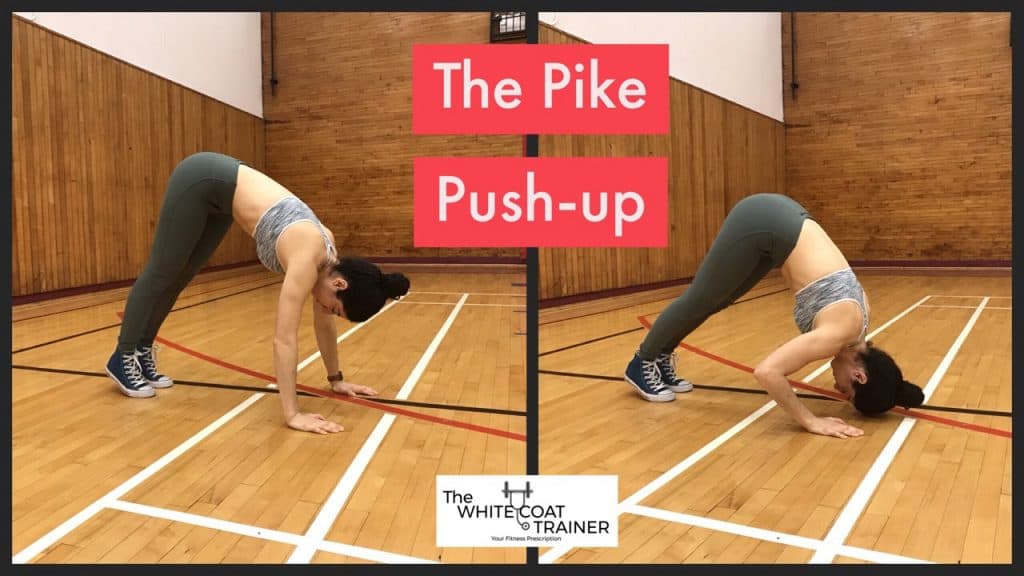
The goal is to press in as vertical of a plane as possible. I go over a few variations you could do in 21 Bodyweight Shoulder Exercises.
The next exercise is the pull-up.
It needs no introduction. This is probably the best upper body exercise of all time.
This movement strengthens the lats, the rhomboids, the scapulae, the mid traps, the biceps, and the core. Just like the push-up, the pull-up has numerous progressions and regressions to fit your skill level.
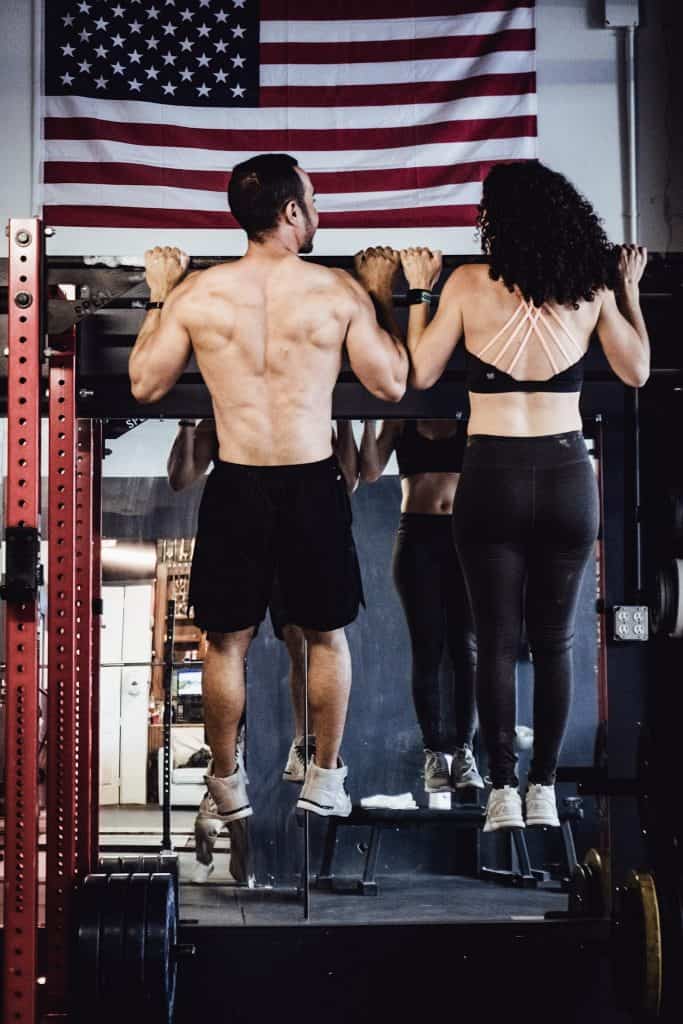
If you can’t do your first pull-up, check out this post.
The third exercise in this workout is the glute bridge.
This movement will train your glutes, hamstrings, and hip extension strength. When starting out you can do glute bridges on the floor with your knees bent.
As you get stronger you can begin elevating your feet, straightening out one leg, doing them with just one leg at a time, and ultimately adding external weights to make it more challenging.
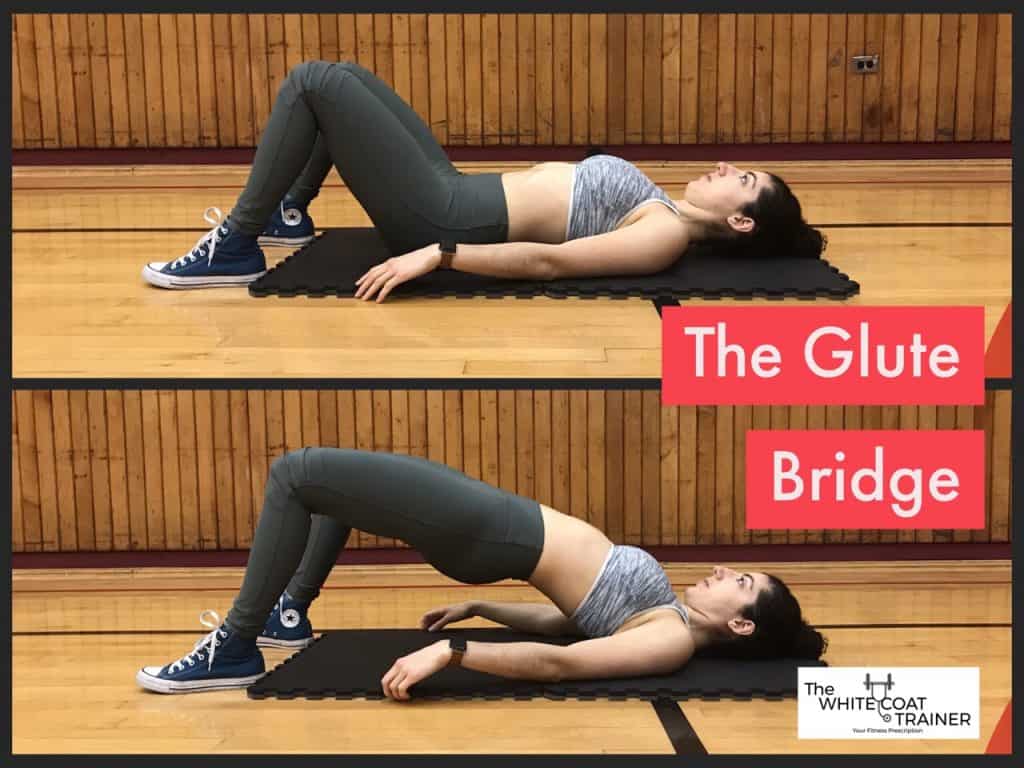
Workout 3
| Exercise | Sets | Repetitions |
|---|---|---|
| Dip Variation | 3 | 8-10 |
| Inverted Row Variation | 3 | 8 |
| Lunge Variation | 3 | 8 each leg |
For the last push-pull-legs workout, you will perform dips, rows, and lunges.
The dip is a combination of a horizontal and a vertical pushing pattern. It strengthens the muscles of the shoulders, the chest, and the triceps.
When performing this exercise, make sure to keep your scapulae retracted at the bottom of the movement and your shoulders externally rotated.
If you are a beginner, I do not recommend the chair dip. Instead, I recommend a feet-supported dip variation, using more and more repetitions as you get stronger.
This is what it looks like.
Ultimately, you can work your way up to harder progressions as seen here: 21 Best Bodyweight Chest Exercises.
The second exercise is the inverted row – which you have already seen before in Workout 1.
The third and final exercise is the lunger variation. This movement is similar to the squat, except you will build upon single-leg knee flexion strength. These exercises also help improve balance and coordination.
The simplest variation is the split squat.
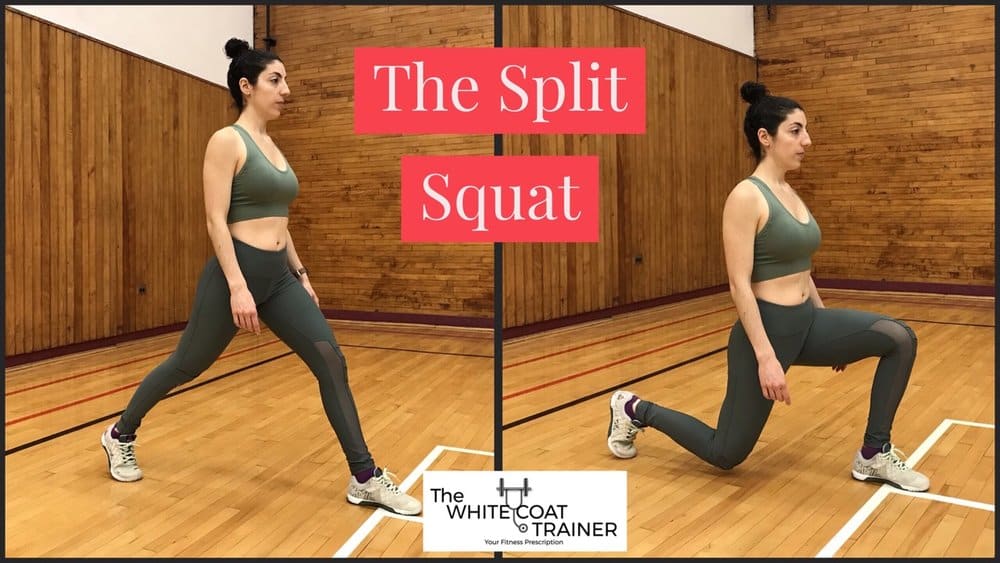
Once you get good at those, you can then progress to more challenging variations such as reverse lunges, and step-ups.
Workout 4
| Exercise | Sets | Repetitions |
|---|---|---|
| Plank Variation | 4 | 20 second holds |
| Leg Raise Variation | 4 | 10 |
The final workout in this program is simply a core workout.
In it, you will perform some type of plank variation,
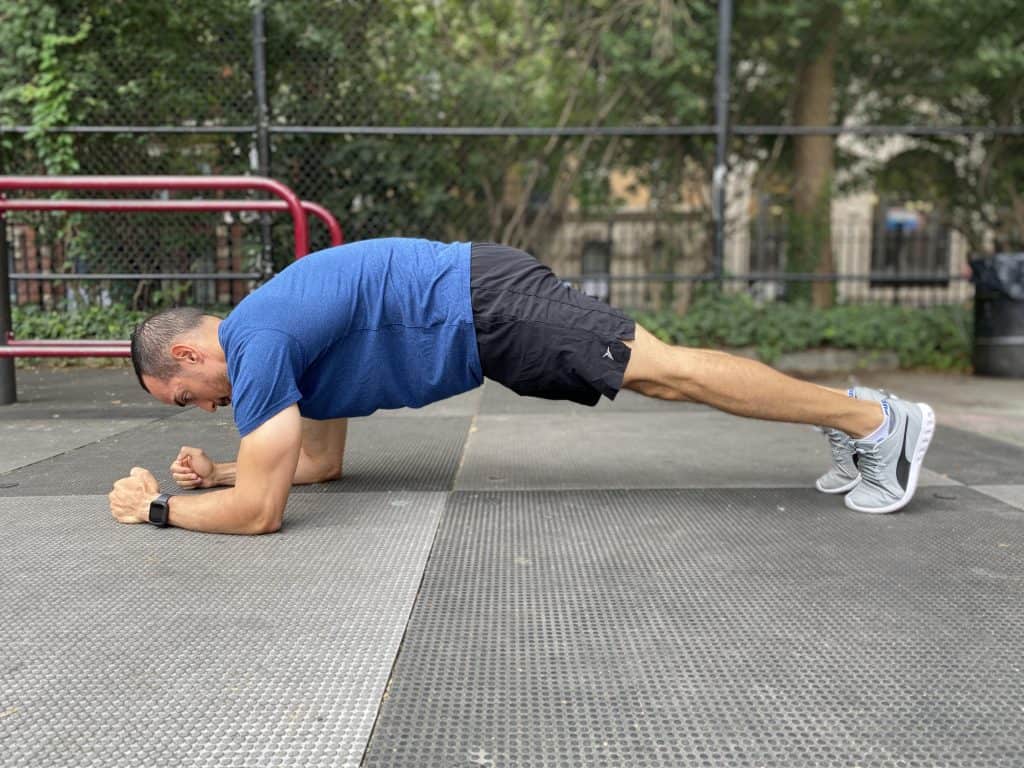
followed by some type of leg raises variation.
This is the hanging leg raise, but it can also be done on the floor.
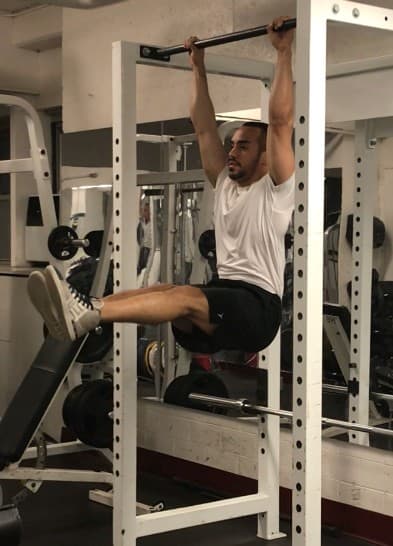
You can choose whatever core exercise you like, but I think these two are the best for beginners learning how to use bodyweight exercise to build whole-body strength.
You can get more ideas here: 17 Advanced Core Exercises.
How To Use This Workout Program
So that is one of the best calisthenics workouts you can do from home in just 30 minutes a day. If you are a beginner, you can do each workout once per week with one day of rest in between.
For example, you can do:
| Monday | Workout 1 |
| Tuesday | Off |
| Wednesday | Workout 2 |
| Thursday | Off |
| Friday | Workout 3 |
| Saturday | Workout 4 |
| Sunday | Off |
Once the workouts become easy, you should use the principle of progressive overload to continue making the workouts more challenging.
The best way to do is by
- increasing the number of reps you do
- increasing the number of sets you do
- adding weights in the form of a weight vest or a heavy backpack
- using a harder calisthenics progression
In this next section, we will talk about using a harder progression.
By the way…
I also created a PDF detailing all of the best calisthenics exercises for each muscle group!
It is broken down by movements with a detailed explanation of how to do them and how to modify them based on your strength and skill level.
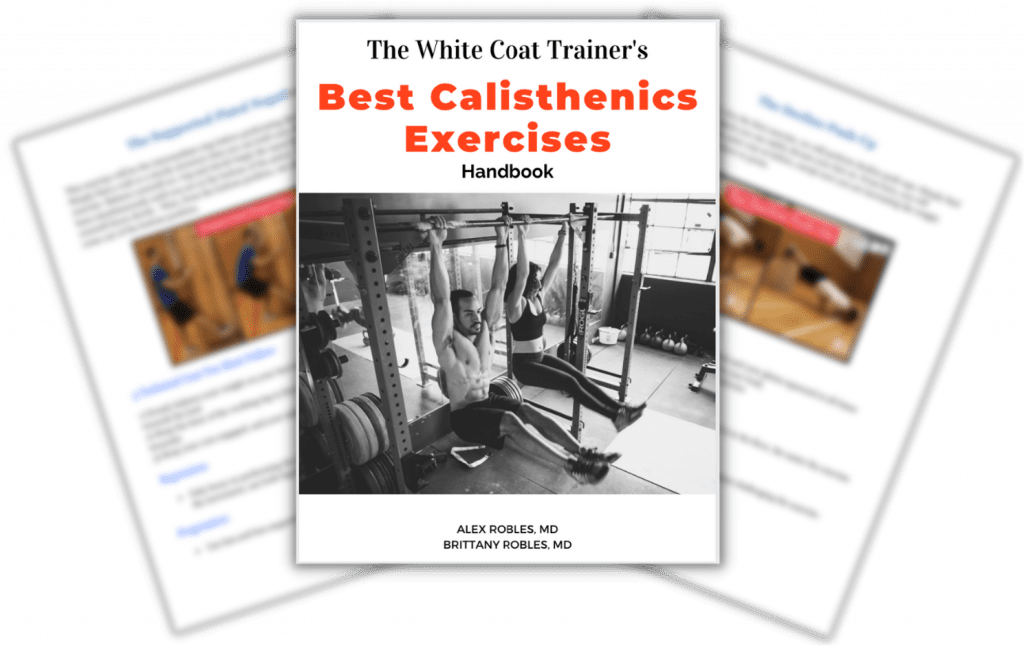
You will find dozens of variations to the most comprehensive calisthenics exercises
You can use these exercises to create even more upper-lower or push-pull leg splits!
Progression Calisthenics Workouts
Once you can no longer add reps or sets to your calisthenics exercises, it’s time to move on to harder progressions.
This is the most important concept in calisthenics if your goal is to continue building strength and muscle. This is the key to breaking through plateaus.
Just make sure to always use proper form when doing some of these advanced exercises.
Now let’s go over some progressions to the exercises listed above.
Examples of Progressions (Starting with Beginner Calisthenics Exercises)
Let’s start with the push-up.
- Incline push-up -> push-up -> close grip push-up -> decline push-up
For the squat:
- Supported air squats -> box squats -> air squats -> pause squats
For the inverted row:
- Knees bent rows -> knees extended rows -> Rows with a pause at the top
For the pike push-up:
- Pike push-up negatives -> pike push-ups -> close grip pike-push-ups
For the pull-up:
- Chin-up negatives -> isometric chin-up holds -> feet supported chin-ups
For the glute bridge:
- Glute bridge -> glute bridge with 3 second pause -> feet elevated glute bridge
For the dip:
- Foot assisted dips -> dip negatives -> standard dips
For the lunge:
- Split squat -> low step-up -> reverse lunges
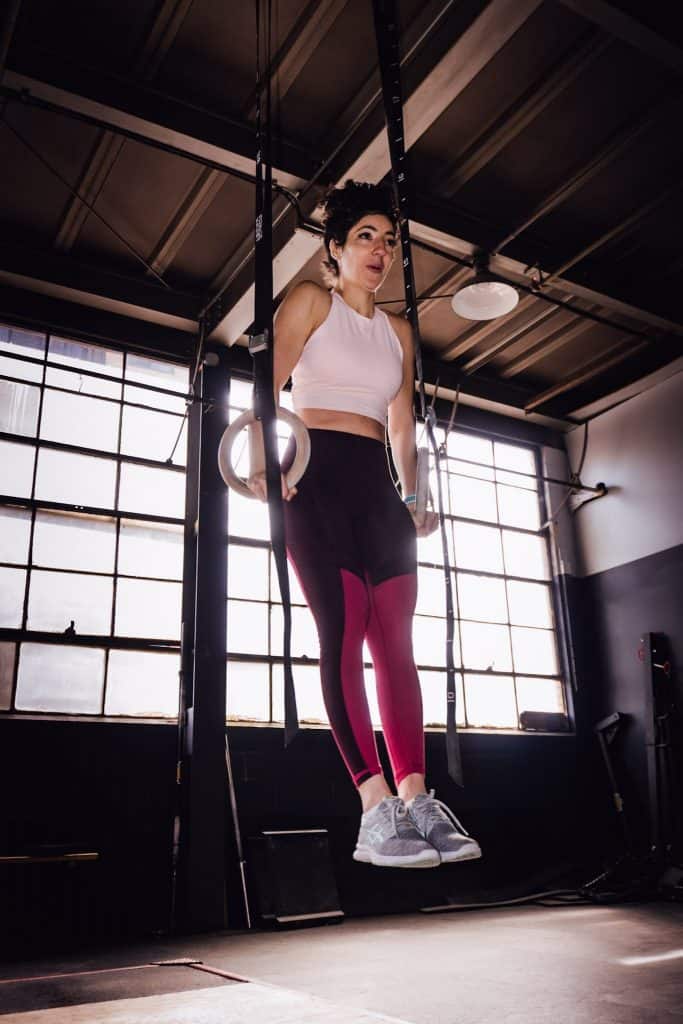
Intermediate Calisthenics Exercises
Once you begin to master the above movements, you can then move on to intermediate calisthenics exercises.
For example:
- Decline push-ups with hands elevated -> Uneven push-ups -> Lever push-ups
- Close stance pause squats -> Single Leg Box Squats
- Feet elevated Inverted Rows
- Feet elevated pike push-ups
- Chest to bar pull-ups -> Close grip pull-ups -> L-pull-ups -> Muscle ups
- Single-leg glute bridge
- Dips with a pause at the bottom -> Ring dips
- Deficit reverse lunges
To see pictures of all these exercises check out: The Complete List of Calisthenic Exercises.
Other Related Questions
How Long Should A Calisthenics workout be?
Calisthenics workouts only need to be 30 to 40 minutes to be effective. This is enough time to train all three broad categories of calisthenic exercises including the push, pull, and leg muscles.
In general, I recommend that you set your workout schedule to perform 3 -4 sessions per week.
What Are The Benefits of Calisthenics?
The major benefit of calisthenics is that it is a great form of resistance training that requires minimal to no training equipment.
You can do a calisthenics workout right now, in the middle of your living room or at the park.
Also, calisthenics requires very little financial investment. I live in New York City. Some gym memberships can cost upwards of $200 a month around here.
With calisthenics, all you need is your own body to get started. Last I checked, that was free.
With that said, I would recommend that you get at least two pieces of equipment.
- A
pull-up bar - A resistance band
I’ll go over these in more detail below.
There are so many different types of pull-up bars you could get. I go over my favorite ones here: The Best Calisthenics Equipment To Build A Home Gym.
Resistance bands are also a great investment because of their portability and versatility. They can make any exercise more challenging while allowing you to do other exercises you wouldn’t normally be able to do.
I go over these in more detail in that same post above, but otherwise, these are the bands I recommend from Amazon.
Get at least 2-3 bands of varying resistances.
Can you build muscle with only calisthenics?
You can definitely build a lot of muscle mass using only calisthenics.
Building muscle requires three things – a stimulus, recovery, and adaptation.
When done properly, bodyweight exercises can provide sufficient resistance to elicit the muscular growth stimulus in your body. The key is that you must perform exercise variations that fatigue your body within the 8-12 rep range. I explain the S-R-A cycle in more depth here.
You must then recover from your workout through a combination of rest and nutrition.
Lastly, you must progressively overload your workouts over time to induce new muscular adaptations from your body.
With that said, calisthenic exercises can only provide a fixed level of weight as resistance. For your lower body, this might not be enough to develop a lot of muscle in your lower body. Once you master the most advanced calisthenic leg exercises, your lower body may not grow past a certain level.
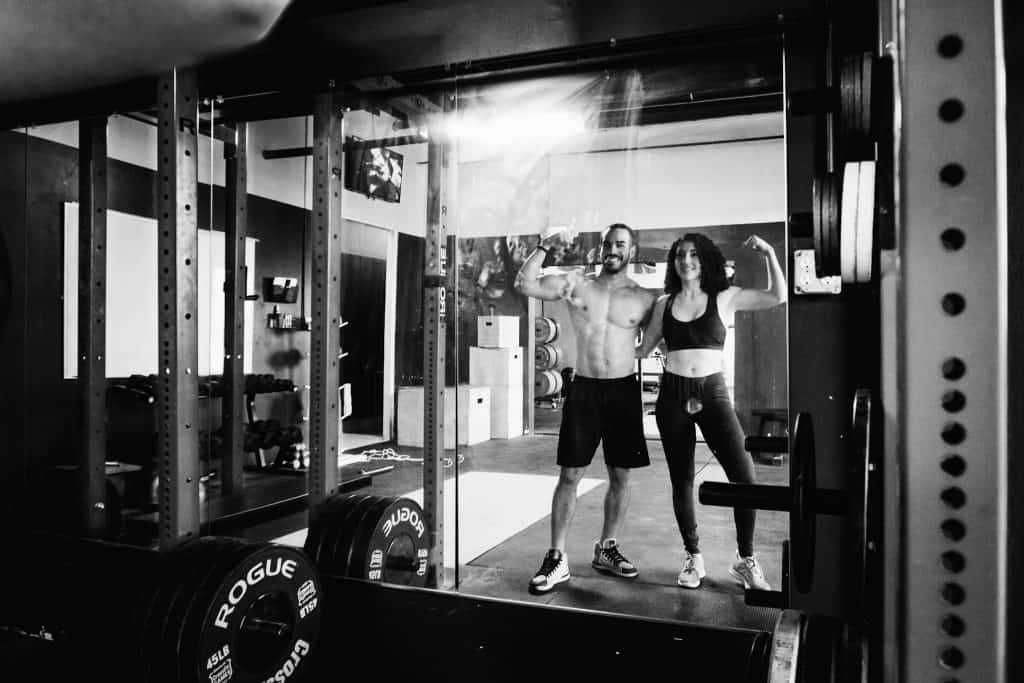
Is Calisthenics Better Than Gym?
Calisthenics vs weights: Which is better?
Both external weights and calisthenics can provide you with enough resistance to improve your overall strength and fitness. If you can do both, do both.
But in general, calisthenics is better if
- You prefer to exercise at home with minimal equipment
- You want to build total body functional strength
- You don’t want to build a lot of lower body muscle
- You are an absolute beginner
Almost all the calisthenic exercises are functional in nature. As a result, they tend to train several muscle groups at once and build your core musculature.
With that said, if your goal is to build the most amount of muscle possible, or develop maximal levels of strength, then weights are better. However, lifting heavy weights does come with a higher chance of sustaining musculoskeletal injuries.
Lastly, calisthenics can be more comfortable to start with, as a lot of the exercises will feel natural. They are easier to learn and less risky.
Overall, I think calisthenics is better than weights, but both have their merits.
Is There Anything Specific For Women?
Check out my post on calisthenics for women to learn the differences between men and women!
If You Are Looking For A Complete 24 Week Program…
Be sure to check out the White Coat Trainer’s Home Workout Program 2.0! Each workout is designed with the most effective calisthenics exercises and organized to build muscle and strength as efficiently as possible.
Plus, each workout will only take you 30 minutes to do!
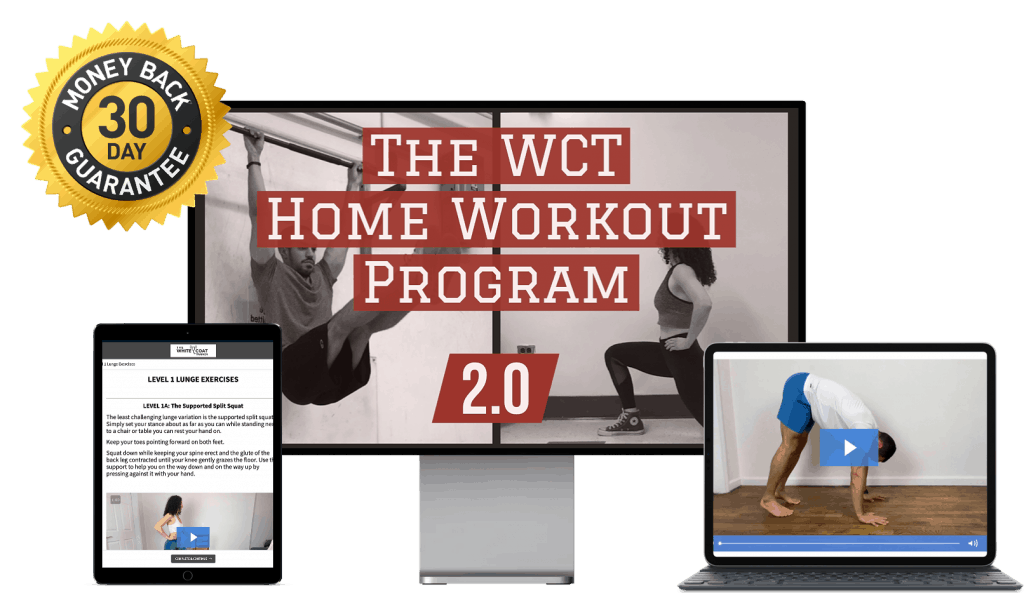
Final Words On Bodyweight Training
Calisthenics workouts are an extremely effective way to build muscle, gain strength, and improve your fitness level. The best part is, they can be done anywhere, especially if you don’t want to train at a gym.
The upfront investment is small, but the payout can be huge.
Give this home workout a try and let me know how it goes for you!
Which variations are you capable of performing? Comment below and let me know!
Related Posts On Calisthenic Workouts At Home
- The Complete List of Calisthenics Exercises (Beginner To Advanced Progressions)
- Calisthenic For Beginners [What You Need To Get Started]
- 9 Essential Pieces of Calisthenics Equipment [To Deck Out Your Home Gym]

Alex Robles, MD, CPT / Brittany Robles, MD, MPH, CPT
Alex & Brittany Robles are physicians, NASM Certified Personal Trainers, and founders of The White Coat Trainer: a resource dedicated to improving the health and fitness of busy professionals using time-efficient strategies. Their advice has been featured in My Fitness Pal, Prevention, Livestrong, Reader’s Digest, Bustle, The Active Times, and more. Learn more about them here.
